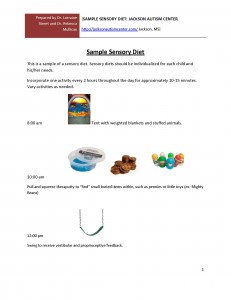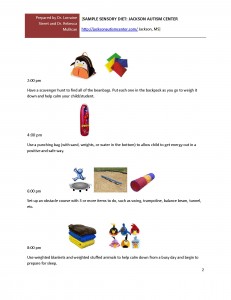Recently, I worked with a colleague of mine and occupational therapist, Dr. Lorraine Street, to form a sensory diet for one of my clients. As you may be aware, lots of children with autism and other disabilities have sensory issues that require frequent assistance from adults to stabilize their sensory state. It is always a goal to work towards self-awareness and allowing individuals to identify their sensory needs and independently take care of those needs. However, along the way, the use of a sensory diet can help kids, teenagers, and adults form a schedule and routine for including sensory items in their day while helping calm and/or alert them for daily activities. The use of sensory equipment may also decrease a child’s sensitivity to texture/touch or it may increase appropriate responsiveness to sensory experiences. Over the years, I have seen great success using sensory equipment in the classroom to help my students. By incorporating sensory activities throughout my students’ day, I was able to help them regulate their sensory state and try new sensory experiences they may not have tried. It is easy to add sensory activities into your typical day. Here are some of the things I did in the classroom: use special sensory songs at circle time (my favorite is “The Brushing Song” from Genevieve Jereb), use theraputty prior to one on one or small group work (pulling the putty and working to strengthen finger grasp), sitting on a therapy ball to complete work, and gardening activities (pulling weeds, packing dirt around flowers, digging).
Activities that can easily be incorporated at home include swinging, jumping on a trampoline, sitting or bouncing on an exercise ball, and using playdoh. Some children enjoy being covered in heavy blankets for bedtime. Starting a sensory diet for your child can help him/her stay relaxed or stop/reduce overwhelming or overloading sensations. For children who are under-responsive to sensory feedback, a sensory diet can help him/her be more alert.
The following is a sample sensory diet that is in place to be followed approximately every two hours throughout the day. I would recommend the advisement or assistance of an occupational therapist to help you best meet the needs of your child or student.


